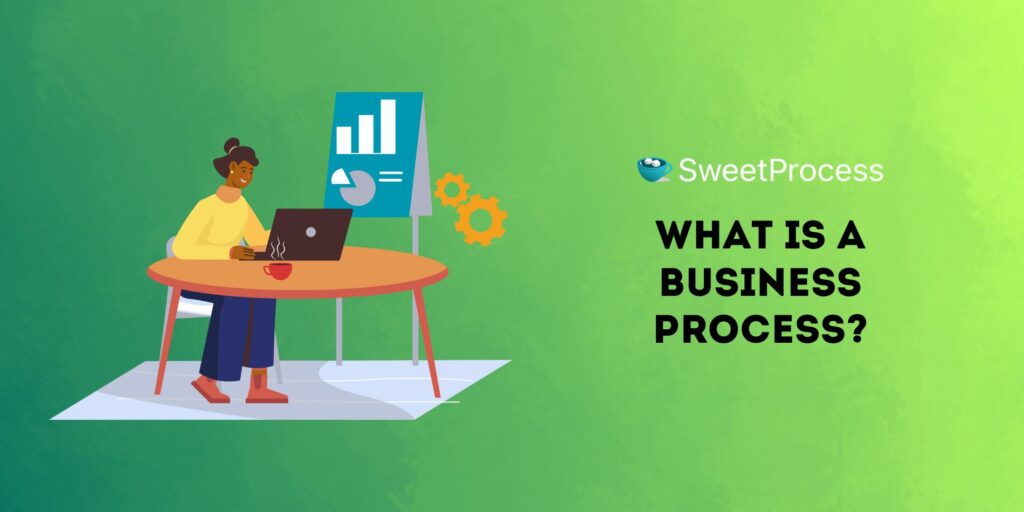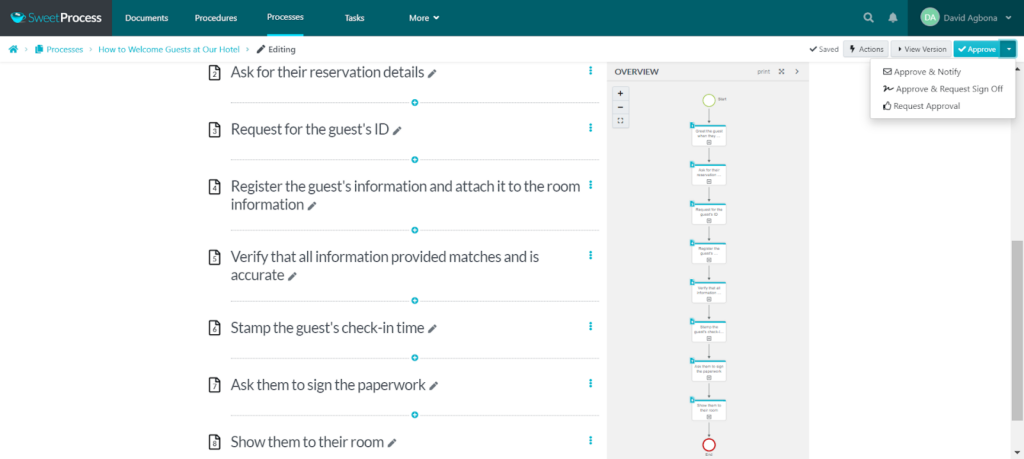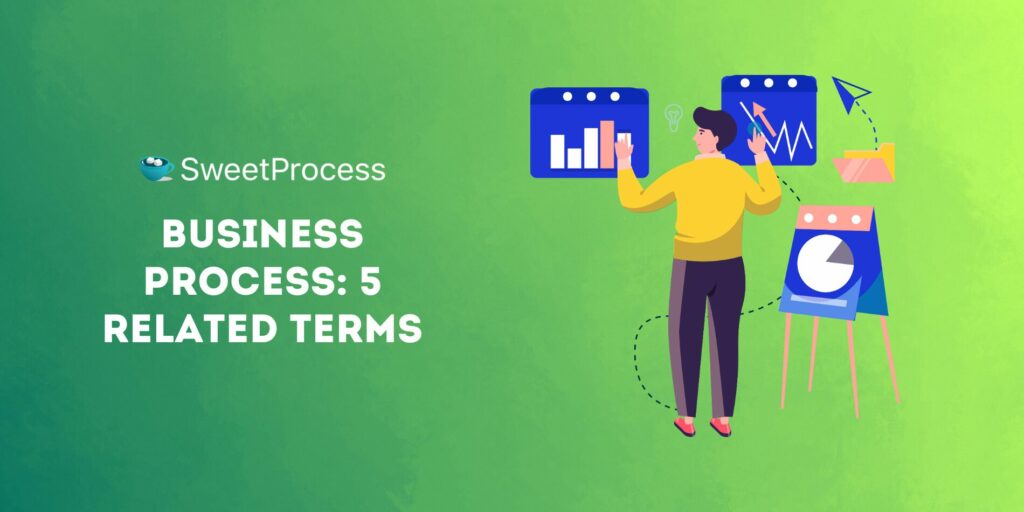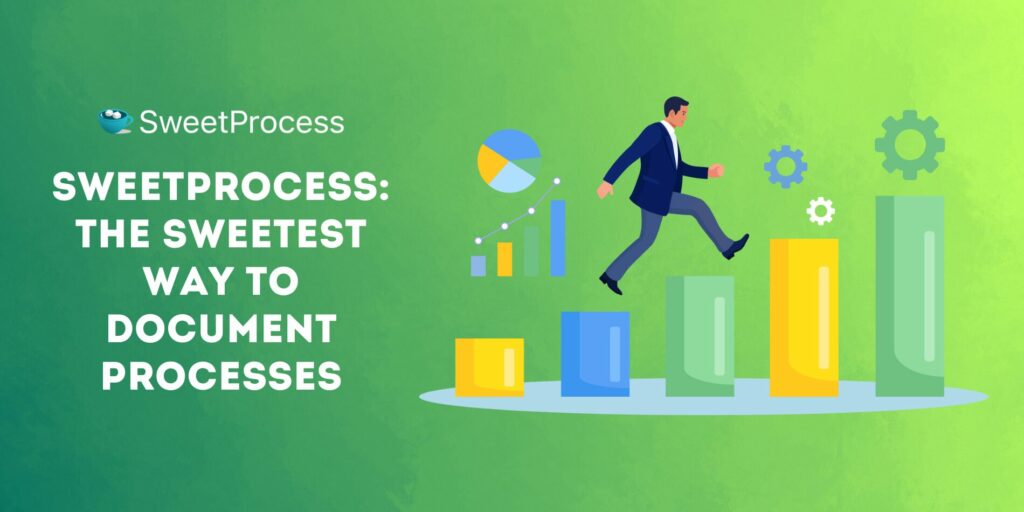Last Updated on March 12, 2025 by Owen McGab Enaohwo

Running a business comes with incredible risk. Twenty-one percent of businesses fail within their first year. Within five years, that number more than doubles to 50%. By the tenth year, 70% of businesses have folded up.
Businesses must grow, or they will surely die. And one of the many strategies for growth is efficiency.
Efficient operations keep a business agile, nimble, and ready to take advantage of opportunities that the markets regularly present.
As teams become more efficient, processes smoother, and delivery quicker, the net effect is growth.
This article will explain business processes, why they are important, how other companies have used them, and how you can implement them.
Today, for only your contact information, you can test drive SweetProcess for free and INSTANTLY begin to grow your business process by process.
Table of Contents
Why Is a Business Process Important?
7 Steps of the Business Process Lifecycle
How SweetProcess Helped ClickFunnels Survive a Hypergrowth Phase
Business Process Examples: 3 Real-World Applications
Document Your Processes With SweetProcess in 7 Easy Steps
Process Improvement: Key Strategies
Business Process: 5 Related Terms
Business Process vs. Business Procedure
Business Process vs. Business Function
SweetProcess: The Sweetest Way to Document Processes
What Is a Business Process?

A business process is a document (or documents) that details the steps required to complete a task.
Processes help teams become more efficient. If a process exists for a task, anyone who wants to execute the task knows exactly what to do from start to finish without guidance.
The ability to autonomously complete tasks means quick completion times because there is no time lost going back and forth.
Processes can be written and stored anywhere, including Word Docs and Google Docs. But these aren’t convenient ways to create, store, and share business processes.
SweetProcess is by far the better option. With SweetProcess, you can easily create and share processes with team members. Even better, you can link multiple processes into a singular database that acts as your tribal knowledge base.
Why Is a Business Process Important?

There are a myriad of benefits to documenting processes and storing them inside software such as SweetProcess.
This section will explore some of the benefits of business process documentation. The first three are some of the more apparent benefits, but you will also find the rest insightful.
Improved Productivity
Essentially, processes help workflows move faster. If your team knows exactly what steps are required to complete a task, they can get work done much quicker and to a higher quality.
If they can get work done faster, it means that more orders can be fulfilled and more customers satisfied, which contributes to profitability.
Consistent Output
The beauty of processes is that steps are done in the same order every time, and the same result is achieved consistently.
In a business where quality is repeatedly required (which is most businesses), a consistent output leads to fewer mistakes, mistakes that would have taken time to fix.
Higher Efficiency
Remember how we said efficiency drives growth?
Here’s why.
Using limited resources to achieve more in shorter time frames, while eliminating almost all waste can increase a business’s profit margin.
The more efficient a business is, the more profitable it can be.
Consistent Customer Experience
Brands are built on reputation. One way to create a reputation is to say and do the same things repeatedly.
If a customer interacts with a business once and the experience is the same as their future interactions, this creates an impression in the customer’s mind.
If that consistency is multiplied over 1,000 customers, those customers will have a positive impression of the brand.
Because customers tend to recommend brands they like and trust, a positive reputation is free marketing.
Compliance
Simplified processes make compliance easier. Many types of businesses are heavily regulated, including health (pharma), food, and maritime.
Processes shine in these types of businesses because if they are aligned with regulatory policies, the business is automatically compliant.
Automation
The only types of businesses that are truly scalable are those that can operate independently. Process automation plays a key role in making this possible by ensuring that workflows run smoothly without constant oversight.
With well-defined business processes in place, teams know exactly what to do, how to do it, and when to do it—reducing the need for hands-on management. For a founder, this means more freedom to take a vacation or focus on strategic growth rather than getting caught up in daily operations.
Attractive to Investors
Business process automation frees up business owners’ time and can make their companies more attractive to investors.
Investors typically like to plug their money into validated systems and get more money than what they put in.
In addition, investors feel secure because they know that systemized businesses won’t break under the pressure of scaled operations. If they scale marketing, advertising, and operations, a systemized business with a strong work culture won’t just fall apart.
An automated business is a validated system because it is self-sustaining.
Opportunities for Improvement
Business process mapping allows a birds-eye view of your processes.
If you can see all your processes laid out in front of you, you can quickly and easily identify gaps and/or areas of waste. This allows you to fine-tune your operation strategy.
Working Toward Long-Term Goals
Processes serve as essential management tools that help founders and managers execute their big-picture strategy effectively.
For example, if a company’s goal is to enhance the tone of its customer service experience, making a few adjustments to the processes within the customer service team can drive this transformation.
Even small process improvements can lead to significant, long-term changes. A well-structured business continuity plan ensures that these improvements remain effective even during unexpected challenges, keeping operations steady and adaptable.
By standardizing workflows and identifying critical procedures, businesses can build a foundation that supports growth while maintaining stability.
Agility
Closely tied to strategy execution is the quickness with which changes can be implemented.
In the example above, remember that we made a big change with just a small process tweak.
This change did not take a lot of time (ideally), and the tone of customer service improved immediately.
Being able to affect changes quickly and easily makes businesses agile and easy for them to adjust and adapt to varying (and sometimes hostile) market conditions.
7 Steps of the Business Process Lifecycle

Now that we have outlined the importance of business processes, let’s look at the process (pun intended) of creating your business process.
Design/Strategy
The first thing before putting pen to paper is to determine what you want your process to achieve.
You should consider your business vision and how your processes will contribute to executing your overall strategy.
If you have existing processes, this is the stage to consider decision points, roles, and responsibilities. The goal is to have a rough idea of the process outline, who will execute it, what steps it will contain, and how it fits into the overall business strategy.
Establishing these beforehand will inform how you write your processes, how you format them, and where you choose to host them.
Model Your Process
Once you have your process outlined, it’s time to turn it into a functional business process model.
Using all the considerations you’ve made in your design/strategy session, flesh out all the steps and then liaise with stakeholders or experienced team members to refine the process as best you can.
SweetProcess has a feature that helps you with your business process modeling using flow charts. With flow charts, you can see how the process moves along decision points and branches and how to optimize your workflows.
Test the Process
Once the model is complete, you can test your process in real time.
The purpose of this is to execute as quickly as possible so that you have data to work with.
There are two basic ways to execute and test your process. The first method is to go live with a small sample of people. This sample should comprise a variety of people so your test can accommodate real-life variances.
If the situation allows (as in the case of repetitive tasks that can be automated), the next method is to use automation software to execute your process.
Monitor the Results
Regardless of what method you choose, record your results to determine the variance between expected results and real-life performance.
Measure your results against established KPIs, noting things like time of completion and rate of errors. Also, collect feedback and ask questions like, “How clear were the instructions?”
The purpose of monitoring is to determine what factors are causing deviations from the intended or expected results.
Optimize
Once you have data to work with, you can improve your process.
You can optimize for speed, accuracy, or both. You can also decide to automate some portions of the process.
Keep in mind, though, that optimization is an ongoing process. A business should keep improving its processes to maintain a competitive advantage.
Document
Presently, all that’s left is to document your process. Write your process in whatever media you like.
Ensure your media is shareable, easy to access, and easy to navigate. This way, you don’t waste time giving directions you were avoiding in the first place.
Improve
But you cannot stop here. You need a system with which you will keep improving all the processes you’ve already documented.
Later, we will see how you can use company culture to create perpetual process improvements.
How SweetProcess Helped ClickFunnels Survive a Hypergrowth Phase

Remember how we said systems and processes are crucial to growth? One of the case studies from our customers that highlights this is ClickFunnels.
ClickFunnels is a bootstrapped software company trying to expand. Like many bootstrapped ventures, it leveraged limited resources for maximum output.
In their hypergrowth phase, ClickFunnels went from 100 employees to 350 employees. Their goal was to add 5,000 customers to their 95,000 customer base.
Clayton Panzeri, the director of customer success at ClickFunnels, describes the hypergrowth phase as trying to keep one’s head above water.
They had previously used a mishmash of Google Docs, Google Sheets, Google Slides, and Microsoft Word Docs. Everything was everywhere, and nobody knew where anything was.
After finding SweetProcess in a top 10 listicle, Clayton was mesmerized by the UI and how simple it was. However, he was skeptical of committing to the software.
Not only would they have to commit to using the software, but they would also have to provide training for their team members.
Even worse, they were skeptical of systemizing their processes because they didn’t want to curtail their creativity and innovation.
Eventually, they took the leap, and Clayton says running the day-to-day tasks has never been easier. They were able to cut employees’ onboarding time from three weeks to one week.
Clayton and his team can focus on business development rather than putting out 1,000 small fires daily.
Scaling is not possible without systems and processes, without tribal knowledge. SweetProcess is the easy, simple way to document your processes and share them.
Click here to see how our software works and how you can use it to grow your own business.
Business Process Examples: 3 Real-World Applications

This section will explore how you can use business processes in different aspects of your business.
Marketing
Every business needs customers. Without customers, businesses quickly die.
Business processes can be used to execute a variety of tasks within the marketing context.
For this example, let’s look at a sample business process for creating a content calendar.
The process could go like this:
- Perform keyword and customer research
- Brainstorm topics based on research
- Decide which topics best align with the general content strategy
- Create a spreadsheet complete with article details and timelines/deadlines
- Assign writers
- Approve
There are many more marketing tasks than the above; you could create processes that help you tackle community management, brand strategy, and lead generation.
Customer Service
When customers do come in, you have to treat them well so that you can establish a positive brand association with your company.
Although customer service is relatively straightforward, there are more layers to customer satisfaction than a generic process to help a customer.
For instance, the processes that would be appropriate for a new customer are different from those appropriate for an older customer.
Use processes to control the quality of your customer’s experiences, and you will have loyal fans who are willing to bring you more loyal fans.
Sales
Although they seem similar, sales and marketing are different. Marketing is a one-to-many venture, while sales is a one-to-one venture.
Marketing is focused on generating buckets of leads and building awareness and brand equity, while sales is laser-focused on converting leads.
The sales process is typically straightforward since an employee only has to work the lead in front of him. However, other activities constitute a sales process and keep the sales team selling.
Document Your Processes With SweetProcess in 7 Easy Steps
Now that we have observed how other businesses have used processes to improve their baseline, we’ll show you how SweetProcess can capture processes.
This example is complete with screenshots so you can follow along and see how easy it is.
Step 1
Log in to access your SweetProcess dashboard. Once there, navigate to “Processes” in the sidebar.
Click the “+” button beside “Processes.”

Step 2
Next, title the process. Doing this will help you keep track of your progress, especially when you’re doing bulk process documentation.

Step 3
Next, proceed to outline the steps.
Do this by first clicking “Add Step.”

Step 4
When you click “Add Step,”a dropdown menu presents three options.
Click “Procedure” to continue.

Step 5
In the field that appears, type the title.

Step 6
From here, you only need to rinse and repeat.

Step 7
Now, approve the process to make it live and shareable.
To do this, navigate to the top-right corner of the screen.
You can either approve it yourself or request approval from someone on your team.

Did you notice the process map automatically generated to the right of the dashboard?
Process Improvement: Key Strategies
Business process improvement is the key to sustaining growth. If you stop at just creating your processes, you’re missing out on opportunities to grow.
The best way to improve your processes is to implement an overarching strategy that resonates throughout the company.
Toyota did this with great success in the 1950s. They called their methodology Kaizen. Executing this methodology created a company culture that encouraged everyone to participate in improving the business processes.
This is much better than combing through processes and jumping through mental hoops, looking for areas of improvement. If you implement a strategy that fosters improvement (like Total Quality Management), team members who regularly perform these tasks can more easily contribute to improvement as they’re closer to the work.
SweetProcess is a suite of tools you can use to execute your process improvement strategy. With our flowchart, you can visualize your process flows and optimize them easily. Sign up today for a free test drive.
Business Process: 5 Related Terms

Below are five terms related to business processes. When you finally create your processes, these are terms (and concepts) you can use to fuel your strategies.
Business Process Management
On a smaller scale, business processes can be handled by a one- or two-person team. But in a big operation, such as in a manufacturing company, many moving parts and more things are at stake.
It becomes critical to create a system to manage, organize, store, and share the processes that keep the business running.
Business process management is the group of activities that help to organize, validate, and improve business processes.
Business Process Mapping
Business process mapping is a fancy way of saying process outline. Process mapping helps to outline the steps in a process, as well as highlight key decision makers and decision branches.
It is a key step in the business process lifecycle.
Business Process Development
This is a strategic step that considers the vision of a business and decides what processes best achieve that goal.
During business process development, key players design processes that are efficient, effective, and in alignment with organizational goals.
This is why it is essential for those who are involved in this stage to have a thorough understanding of the business.
Business Process Analysis
Business processes are analyzed for the purpose of improving them.
Tools like flow charts first help to visualize the process before they can be analyzed and finally improved.
During business process analysis, the focus is typically on identifying areas for improvement as well as any process bottlenecks.
Business Process Integration
Most business functions coexist with other functions. Business process integration helps to connect multiple processes together, so that complex business functions can keep running.
Just like the name “integration” suggests, BPI implies the connection of workflows and processes with APIs across departments and even across separate businesses.
Business Process vs. Business Procedure
Although synonymous, there are differences between business processes and procedures.
Business processes, as we discussed, contain a series of steps to achieve an outcome or to complete a task. They don’t typically contain any other details.
On the other hand, business procedures are detailed work instructions on how to execute a process step.
Procedures give processes a depth that they would otherwise lack, which further increases the precision with which team members can complete tasks.
Business Process vs. Business Function

Business functions can be thought of as general categories of activities which move a business forward.
Respiration is a bodily function. But the process for that is (roughly) inhale, filter, purify, convert, distribute, and finally, exhale waste.
Here’s a more ’businessy’ example to drive the point home.
Marketing is a core business function. However, within that function, there are multiple tasks that constitute the marketing function.
You could have a process detailing how you want your lead gen team to find and qualify leads. You could also have another process setup for your design team to validate their design(s) against your overarching brand strategy.
But to execute these marketing tasks (business functions), you have to create processes that execute them.
SweetProcess: The Sweetest Way to Document Processes

Although there are many tools and strategies you can use to grow your business, business processes and systems remain the simplest and easiest way to scale profitably.
SweetProcess is a suite of tools that allows you to improve and automate your business in ways you never thought possible.
With process tools featuring a flowchart, you can document and share every type of organizational process asset, from processes to policies.
Our suite of tools can handle task management, too. This means you can assign processes directly to team members and manage them all from one dashboard.

